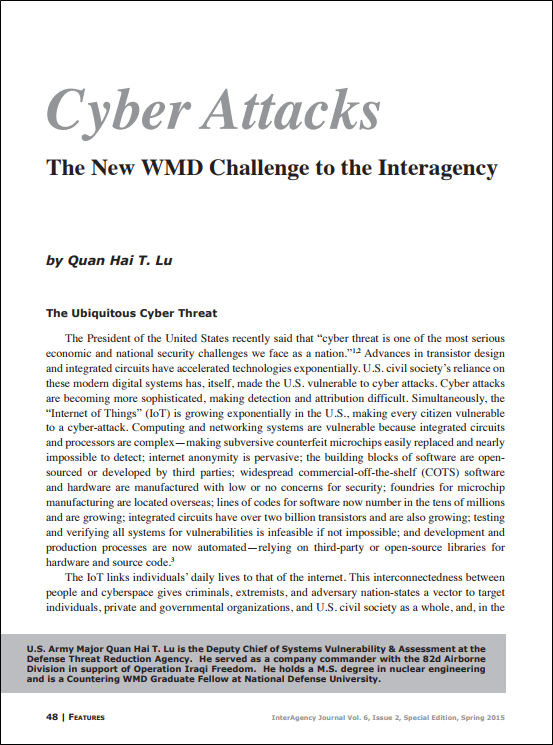Featured Article: Cyber Attacks The New WMD Challenge to the Interagency
Featured article:
Cyber Attacks The New WMD Challenge to the Interagency
by Quan Hai T. Lu
The President of the United States recently said that “cyber threat is one of the most serious economic and national security challenges we face as a nation.” Advances in transistor design and integrated circuits have accelerated technologies exponentially. U.S. civil society’s reliance on these modern digital systems has, itself, made the U.S. vulnerable to cyber attacks. Cyber attacks are becoming more sophisticated, making detection and attribution difficult. Simultaneously, the “Internet of Things” (IoT) is growing exponentially in the U.S., making every citizen vulnerable to a cyber-attack. Computing and networking systems are vulnerable because integrated circuits and processors are complex—making subversive counterfeit microchips easily replaced and nearly impossible to detect; internet anonymity is pervasive; the building blocks of software are opensourced or developed by third parties; widespread commercial-off-the-shelf (COTS) software and hardware are manufactured with low or no concerns for security; foundries for microchip manufacturing are located overseas; lines of codes for software now number in the tens of millions and are growing; integrated circuits have over two billion transistors and are also growing; testing and verifying all systems for vulnerabilities is infeasible if not impossible; and development and production processes are now automated—relying on third-party or open-source libraries for hardware and source code.
The IoT links individuals’ daily lives to that of the internet. This interconnectedness between people and cyberspace gives criminals, extremists, and adversary nation-states a vector to target individuals, private and governmental organizations, and U.S. civil society as a whole, and, in the process, it has inspired a fear of the unknown. In short, cyber is the new weapon of mass destruction (WMD) threat, and addressing it will require marshalling the resources of the entire interagency…
Read the full article
Cyber Attacks The New WMD Challenge to the Interagency PDF
Download the complete edition
U.S. Army Major Quan Hai T. Lu is the Deputy Chief of Systems Vulnerability & Assessment at the Defense Threat Reduction Agency. He served as a company commander with the 82d Airborne Division in support of Operation Iraqi Freedom. He holds a M.S. degree in nuclear engineering and is a Countering WMD Graduate Fellow at National Defense University.

Posted: January 17, 2018 by Simons Center
READ THE LATEST UPDATES FROM THE SIMONS CENTER
"*" indicates required fields


